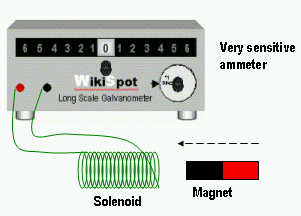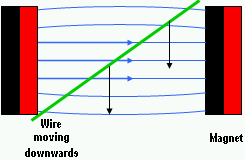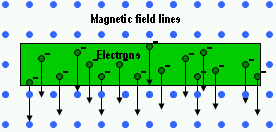Electronics/Magnetic Field
< ElectronicsMagnetic Field: B
A magnetic field is generated due to:
- Magnetic moment.
- Moving charge.
- Magnets have two poles, a north and a south.
- Like poles repel, unlike poles attract.
- Magnets will try to align their poles.
- North and south pole: pole of earth is reversed; geographic north is magnetic south and vice versa.
- Polarity: the alignment of the magnetic field.
- Magnetic monopole: the idea that a single independent pole can exist
- Pauli-exclusion principle: Two electrons cannot occupy the same state.
- Spin: quantum property of electrons, which gives them intrinsic angular momentum. This means, they act as if they were perpetually spinning around their own axis.
- Permanent dipoles: These occur when 2 atoms in a molecule have substantially different electronegativity - one atom attracts electrons more than another becoming more negative, while the other atom becomes more positive. See dipole-dipole attractions.
- Instantaneous dipoles: These occur due to chance when electrons happen to be more concentrated in one place than another in a molecule, creating a temporary dipole. See Instantaneous dipole attraction.
- Induced dipoles: These occur when one molecule with a permanent dipole repels another molecule's electrons, "inducing" a dipole moment in that molecule. See induced-dipole attraction.
- magnetic dipole: Analogous to electric dipole. It refers to a magnetic field that looks as if it came from a pair of north and south monopoles, infintesimally close together.
- magnetic moment (u): The tendency of an object to align itself with a magnetic field. This alignment creates a PE (U). A current carrying loop has a magnetic moment. Electrons and many nuclei have intrinsic magnetic moments due to their quantum spin. The electrons generally come in pairs, whose intrinsic magnetic moments cancel, but they may still produce a magnetic dipole because they rotate (have orbital angular momentum), or produce a magnetic quadropole because of incomplete cancellation. These intrinsic magnetic moments create some of the macroscopic effects of magnetism, such as Nuclear Magnetic Resonance.
An object with a magnetic moment creates an magnetic dipole
- intrinsic magnetic moment: The moment which a thing has. Due to intrinsic angular momentum.
Permeability: μ
- Permeability: (μ) How much a material becomes magnetized in response to a magnetic field.
- Permeability of vacuum: (μ0): 4π × 10-7 N·A-2 (exactly).
- Relative Permeability: (μr) Permeability of materials compared to that of the vacuum.
- Absolute magnetic permeability (μ): = μ0(1 + χ). henry / meter.
- Magnetic susceptibility (χ): the fractional part of the relative permeability.
If χ is positive the magnetic field increase and the material is paramagnetic and if χ is negative the magnetic field decreases and the material is diamagnetic.
Paramagnetism
Paramagnetism: (with magnetism) tendency of a magnetic dipoles to align itself with an external magnetic field due to the effects of spin. By aligning themselves the dipoles strengthen the external magnetic field. (relative magnetic permeability > 1, magnetic susceptibility 10-3 to 10-5) When the magnetic field is removed thermal motion will quickly disrupt magnetic alignment. Paramagnetism acts on each dipole of an atom separately with no interactions between the dipoles. Behaves like a bar magnet when subject to an external magnetic field.
M magnetisation, B magnetic flux, T is absolute temperature (Kelvin), and C is a material-specific Curie constant. Increasing the magnetic field makes paramagnetic materials more magnetic, decreasing the temperature reverses this. Curie's is accurate when saturation is low and stops working as the material becomes saturated.
Diamagnetism
- Diamagnetism: (against magnetism) The orbital motion of electrons forms a microscopic current loop that has a magnetic dipole moment. A purely diamagnetic material is a superconductor, which is a phase transition that has no magnetic field and no resistance.
- Meissner-Ochsenfeld effect: the exclusion of a magnetic field from the inside of a superconductor. Also called perfect diamagnetism.
- cooper pairs: When electrons of opposite spin become paired due to low energy. Like atoms bonding. Being in a cooper pair binds electrons together so they are not scattered from the ions in the material. This causes the resistance of the material to become zero.
- High-temperature superconductivity: superconductivity at temperatures high enough to use liquid nitrogen rather than liquid helium as a coolant.(Important because liquid nitrogen is cheap and easy to obtain)
- superfluidity: When atoms are cooper paired due to spin. Turns a solid into a gas. A state of matter characterized by the complete absence of viscosity. Thus superfluids, placed in a closed loop, can flow endlessly without friction.
- phonon: thermal energy in a solid. Takes the form of vibrations. As a solid gets cold it stops vibrating and forms cooper pairs. Responsible for electron pairing and electrical conductivity, how well a material conducts charge.
- copper, bismuth
Ferromagnetism
- magnetization: zero above Curie temperature.
- spontaneous magnetization: the tendency of spins to align without an applied magnetic field.
- Ferromagnetism: (iron magnetism) Phenomenon by which materials exhibit spontaneous magnetization. Most common and one of the strongest forms of magnetism. Found in bar magnets and permanent magnets. Magnetic moments are partially aligned in magnetic domains. Increasing temperature causes thermal fluctuations and destroys alignment. Above Curie temperature ferromagnetic domains melt away (no net spontaneous magnetization) if there is no external magnetic field, and the material become purely paramagnetic. The Pauli Exclusion principle causes magnetic dipoles to align in the same direction with lower energy known as exchange energy. Over distance dipoles repel each other. This is the principle behind magnetic domains. A Block Wall is the transition between magnetic regions. A strong magnet will align the domains.
- iron, steel, nickel, cobalt, and some alloys and ceramics.
- Curie temperature: Temperature at which a ferromagnetic material undergoes a phase transition and becomes paramagnetic. At this temperature magnetic susceptibility is theoretically infinite. Phase transition.
- Curie point: Above which material becomes paramagnetic. When combined with ferromagnetism follows hysteresis curve with applied field. Used as temperature control in soldering irons.
- Curie points: dysprosium -188 °C gadolinium 16 °C nickel 358 °C iron 770 °C cobalt 1131 °C
- Antiferromagnetism: The spins of electrons align an a regular pattern.
- Neel temperature: The temperature at which antiferromagnetic materials undergo a phase transition and become paramagnetic due to thermal energy.
- spin glass: exhibits high magnetic frustration.
- magnetic frustration: Its magnetic structure is disordered even at low temperatures.
Permanent Magnets

Ferromagnetic materials make up permanent magnets.
To understand how a permanent magnet is made and destroyed it is necessary to look at the microscopic structure of a magnetic material such as iron. A piece of iron is made up of lots and lots of tiny little magnets called domains. In unmagnetised iron these domains have their north poles pointing all over the place in a random way, but when the iron is put in a strong magnetic field the domains line up with the field. The iron becomes magnetised.
Once it has become magnetised, the magnet's own field is strong enough to keep itself magnetised even after it is removed from the external field.
Picture Hysteris Curve
Hysteris curve. heat destroys magnetism if the material is heated above its Curie point.
- Remanence: (Bd, Mr) The amount of magnetism remaining after a magnetic field is removed. Less than the applied magnetic field.
- Residual induction:
- Retentivity: retains some residual magnetism.
- Saturation: The maximum amount of alignment that can occur in a magnet due to a magnetic field. When the majority of dipoles in a material are aligned with an external magnetic field.
- Coercivity: The strength of the magnetic field needed to reduce to magnet from saturation to zero.
- Magnetic flux density: in tesla (T)
- Magnetic field strength: Ampere / meter.
- Compass: A small bar magnet that aligns itself with an external magnetic field. Talk about earth's magnetic field, how its south pole is our north pole, how it keeps switching and is weak.
- Molecular Magnets:
- hysteresis: when an external magnetic field is applied, the ferromagnet takes up some of the field
and becomes more aligned. When the field is removed the magnet retains some of the field and is magnetized.
- hysteresis loop: when an alternating magnetic field is applied to a ferromagnetic material. The material is less magnetized than the magnetic field.
- electrical hysteresis: occurs in ferroelectric material, where domains of polarisation contribute to the total polarisation. Polarisation is the electrical dipole moment (either C·m-2 or C·m).
- electrical dipole moment:
Moving Charge
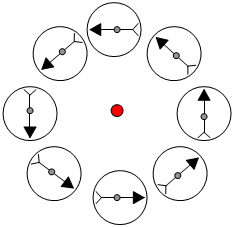
When a negatively charged particle such as an electron moves through space or a wire it generates a magnetic field that circles counterclockwise in a plane perpendicular to it. This is part of Ampere's law. For a positively charged particle the magnetic field is clockwise. The faster the charged particle moves the larger the magnetic field.
Inductance
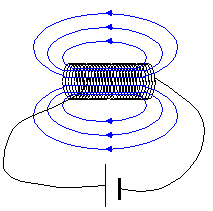
Self inductance This is what happens when you turn on DC in an inductor.
- The voltage increases very rapidly ( in a matter of ms) as you turn on the switch.
- This causes a very rapidly changing current to flow.
- This current has an associated magnetic field which also changes very rapidly.
- The rapidly changing field induces an e.m.f. (Faraday’s Law) that tends to oppose the increase of current (Lenz’s Law). However it cannot stop it increasing completely, just slow it down.
- Once the current reaches it's maximum (determined by the voltage and the ordinary resistance of the wire) it ceases to change, the magnetic field becomes constant and the back EMF goes to zero.
All remains calm until you try to turn the thing off
- The field collapses very suddenly
- The changing magnetic field induces a back EMF which tries to oppose the collapse of the field (Lenz’s Law again)
For large coils the EMF can be huge, sparks can fly!
Isn't really an issue for DC though except when turning on and off. But for AC the current is varying all the time, so things never settle into a steady state. The higher the frequency, the faster things are changing and so the greater the inductance. I hope all this is reasonably clear now. Theresa knott 13:49, 30 Apr 2004 (UTC)
Electromagnet
A magnetic hose that acts like a bar magnet. As the current increases the magnet becomes more repulsive to other magnets. Used as a switch for magnetic materials and to pick up magnetic material such as cars at scrapyards.
To make a good electromagnet we use a 'soft iron' core. Soft iron has the property of being easy to magnetise. It also loses its magnetism very easily once the electric current is turned off. Steel can also be used as the core of an electromagnet, but steel does not lose its magnetism once the electric current is turned off. It stays magnetised.
When a current is switched on, or off, it creates a changing magnetic field, which in turn creates voltages that oppose the current. This is the basis for inductance.
By coiling the wire up we can make a solenoid. The magnetic field of a solenoid looks like the field of an ordinary bar magnet.
A solenoíd makes a pretty weak bar magnet on its own but if a piece of iron is put inside the solenoid the field becomes much much stronger. Try the following experiment:
- Wrap a piece of plastic coated wire around a pencil.Remove the pencil then connect to a power supply set at 1V DC current. sprinkle iron filings around thwe coil of wire. Put a plotting compass near the wire. Try to pick up a paper clip.
- Wrap a piece of plastic coated wire around a large nail. Repeat all of the above experiments
You will find that the solenoid with the iron core is very much stronger than the one with the air core.
Q1) Why is it important to use plastic coated wire?
Mutual Inductance
- induced current: magnetic field creates current.
- eddy current: a current induced by electromagnetic waves.
Mutual inductance is just like inductance except that the magnetic field from the current in one solenoid is creating voltage in a different solenoid, as well as in itself.
- transformer: Transformers and transformer design: Transformer Design
Toroid
Picture of a toroid
A toroid is a solenoid that wraps around on itself.
toroid: A donut shaped inductor where the magnetic fields stay contained within it. Has an air gap.
A Toroid is a doughnut-shaped object enclosed by a torus. It has a ring-shaped surface generated by rotating a circle around an axis that does not intersect the circle. Usually, a toroid is composed of a coil of insulated wire in a donut shape (and is usually composed of iron or similar metals).
Toroids are inductors in circuits. They are primarily used in low frequencies transception for the inductance properties needed. Toroids possess greater inductance properties and carry greater current than similarly constructed solenoids. Toroidal coils reduce resistance, due to diameter and number. In a toroid, magnetic fluxes are confined in the toroid's core.
a toroid magnifies current.
Magnetic Fields and Electric Fields
Notice the similarity between magnetism and electricity. Electricity attracts neutral material (recall a rubbed balloon picking up small bits of paper). Electricity comes in two forms: positive and negative. Like charges repel unlike, charges attract. Physicists long ago realised that these similarities were important. It is now realised that electrcity and magnetism are closely related forces. They are really two different aspects of the same force! We call that force electromagnetism. This next section of the electrcity module is probably the hardest, but it is also the most interesting. Work out the problems in the text as you go along and you will be able to cope.
A changing electric field creates a magnetic field. Conversely, a changing magnetic field creates an electric field.
used to create photon / radio waves
This means that electric currents produce magnetic fields and changing or moving magnetic fields produce electric currents. This module looks at this property of electric and magnetic fields in detail. You will learn about the magnetic fields generated by a wire and a solenoid, then go on to look at motors, generators, and transformers.
Any charged particle in a magnetic field feels a force perpendicular to both the field and its own velocity.
So far we have looked at the effect of putting a current in a magnetic field and seeing that there is a force on the wire that carries the current. On this page we will look at a related effect known as induction.
Talk about straight magnetic fields and electrons moving in circular path.
Talk about how magnetic fields alter the paths of charged particles.
For a more math oriented explanation of Electric and Magnetic Fields consult Electrodynamics.
Notes
- Spot galvanometer: (mirror galvanometer) A very sensitive ammeter that can measure tiny currents.
Experimental results
| The magnet is moved into the coil. | The spot deflects to the left indicating that a small current is flowing. |
| The magnet is left inside the coil. | The spot comes back to the middle showing the that no current is flowing. |
| The magnet is pulled out of the coil. | The spot deflects to the right indicating that there is a current flowing again but this time in the opposite direction. |
| The experiment is repeated except this time the magnet is inserted into the coil very slowly. | There is still a deflection but this time it's much less than before indicating a smaller current is flowing. |
| The magnet is turned around. | The results are the same as above except the deflections are reversed. |
| The magnet is kept still but the coil is moved. | The results are as above. |
Conclusions
- If there is relative movement between a coil of wire and a magnet, there will be a current induced in the coil.
- The faster the movement the bigger the current.
- Reversing the magnet, or the direction of movement reverses the direction of the induced current.
Theoretical explanation of what's going on (Advanced)
So now we know what happens we have to come up with an explanation. Look at the diagram below.
In this diagram the green line represents a wire that is going into the screen or page. It is at right angles to the magnetic field between the two bar magnets. The wire is moved downwards so that it "cuts" the field lines. This induces an e.m.f. (voltage) along the wire. It is this e.m.f. that causes a current to flow if a complete circuit is made. So now we know why you get a current. It's caused by the induced voltage, but why do you get a voltage?
This is a close up of the wire seen end-on. The blue circles represent where the magnetic field lines stick out of the screen or page. They are coming straight out of the screen.
The wire is made of a metal and so has many free electrons. As the wire moves downwards each individual electron travels downwards too. They effectively form loads of little current flowing down. From the motor effect we know that if a current flows in a magnetic field there will be a force. In this case the force pushes the electrons to the right. It is the electrons all moving up to the right end of the wire that causes the voltage difference.
So, the motor effect can induce an e.m.f. This is one of two ways magnetic fields can induce an e.m.f
Q3) Imagine more than one loop of wire cutting through the magnetic field.Each loop of wire has its own e.m.f. induced on it. If the wires are joined up, it's as if they are little cells in series. Fill in the blanks " As the number of windings on the solenoid increases the value of the induced voltage ______________.
When a current flows down a wire it creates a magnetic field. To see this place a small plotting compass near the wire and turn the current on.The compass needle will deflect. The shape of the magnetic field around a wire is circular. look at the diagram on the right. The wire is coming straight out of the screen so you only see it's cross section (the red circle) The plotting compasses show how the field wraps around the wire.
Making the field stronger
To make the field stronger we can:
- Use a soft iron core
- Increase the amount of current flowing in the wire
- Increase the number of turns on the solenoid.
Reversing the field
To make the north pole and south pole swap positions we can
- reverse the direction of the current by swapping the positive and negative leads on the power pack.
- Wind the wire the other way round. {So if you wound it clockwise, take it off and wind it anticlockwise.
Talking of north and south poles, there is a little trick to find out which end will be the north pole and which end will be the south.
Look down the solenoid and work out which way the current is flowing. Remember current flows from the positive to the negative terminals on the power pack. If the current is flowing clockwise the end will be a south pole. If it looks like it's going anticlockwise the end will be a north pole. The easy way to remember this is to put arrows on the end of a capital N and S like this.
